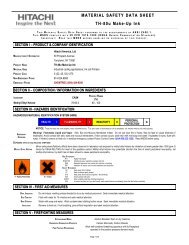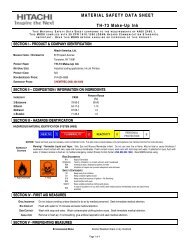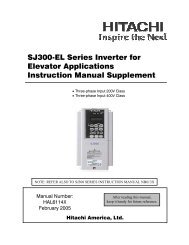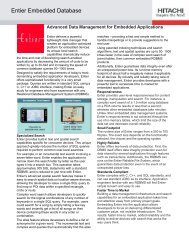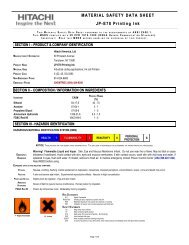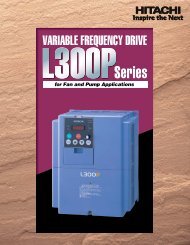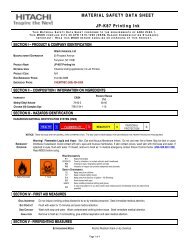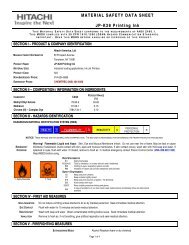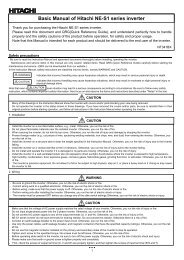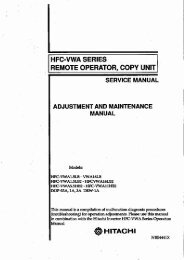SJ700-2 Instruction Manual NT204DX - Hitachi America, Ltd.
SJ700-2 Instruction Manual NT204DX - Hitachi America, Ltd.
SJ700-2 Instruction Manual NT204DX - Hitachi America, Ltd.
Create successful ePaper yourself
Turn your PDF publications into a flip-book with our unique Google optimized e-Paper software.
Chapter 4 Explanation of Functions<br />
4.3 Functions Available When the Feedback Option Board (SJ-FB) Is Mounted<br />
4.3.1 Functions requiring the SJ-FB<br />
Related code<br />
- The feedback option board (SJ-FB) is generally required in the following<br />
A044: V/F characteristic curve selection, 1st motor<br />
A001: Run command source setting<br />
cases:<br />
A076: PV source setting<br />
When "05" (V2: vector control with sensor) is specified for V/F<br />
A141: Operation-target frequency selection 1<br />
characteristic curve selection, 1st motor(A044)<br />
A142: Operation-target frequency selection 2<br />
When pulse train frequency input is specified by one of the following<br />
methods:<br />
- "06" (pulse train input) is specified for the run command source setting (A001).<br />
- "10" (operation function result) is specified for the run command source setting (A001), and "05" (pulse train frequency)<br />
is specified for operation-target frequency selection 1 (A141) or operation-target frequency selection 2 (A142).<br />
- "03" (pulse train frequency input) is specified for the PV source setting (A076).<br />
- For the wiring and DIP switch setting of the SJ-FB, refer to the instruction manual for the SJ-FB.<br />
- You can check the direction of motor rotation with the actual-frequency monitoring function (d008). For checking with<br />
this monitoring function, specify "00" (VC) for the V/F characteristic curve selection (A044) and make the inverter<br />
operate the motor. (Normally, a positive frequency is monitored when a forward-operation command is input, and vice<br />
versa.)<br />
4.3.2 V2 control pulse setting<br />
To use the V2 control pulse setting function, specify "00" (ASR: speed control mode)<br />
or "01" (APR: pulse train position control mode) for the control pulse setting (P012).<br />
In speed control mode, select a device to input frequency commands by the<br />
frequency source setting (A001).<br />
In pulse train position control mode, each frequency command is<br />
generated from a position command pulse train and the feedback<br />
of the position data detected by the encoder. The position command is input via an intelligent input terminal, to which the input of the<br />
pulse train position command is assigned. You can perform the position control with the command.<br />
Select one of three input formats for the pulse train position command by the pulse train mode setting (P013).<br />
To use the pulse train position control mode, assign function "48" (STAT) to an intelligent input terminal. The inverter accepts a pulse<br />
train position command only when the STAT terminal is on.<br />
You can clear the position deviation data by an external signal. Assign function "47" (PCLR) to an intelligent input terminal. Turning<br />
the PCLR on and off clears the position deviation data in the inverter.<br />
To output a speed deviation error signal, assign function "22" (DSE) to an intelligent input terminal, and specify a deviation level as<br />
the speed deviation error detection level (P027). If the deviation of the actual frequency (motor speed) from that specified by the<br />
frequency command exceeds the error detection level (P027), the inverter will output the DSE signal.<br />
Item Function code Data or range of data Description<br />
00 ASR: Speed control mode<br />
01 APR: Pulse train position control mode<br />
Control pulse setting<br />
P012<br />
02 APR2: Absolute position control mode<br />
03<br />
HAPR: High resolution absolute position<br />
control mode<br />
00 MD0: 90°-phase-shift pulse train<br />
Pulse train mode setting (*2)<br />
P013<br />
01<br />
MD1: Forward/reverse operation command<br />
with pulse train<br />
02<br />
MD2: Forward-operation pulse train with<br />
reverse-operation pulse train<br />
Encoder pulse-per-revolution<br />
(PPR) setting<br />
Position loop gain setting (*1)<br />
P011<br />
P023<br />
128. to 9999. or 1000 to<br />
6553 (10000 to 65535)<br />
(pulses)<br />
0.00 to 99.99 or 100.0<br />
(rad/s)<br />
0.00 to 99.99 or 100.0 to<br />
120.0 (Hz)<br />
Related code<br />
P012: Control pulse setting<br />
A001: Frequency source setting<br />
P013: Pulse train mode setting<br />
P011: Encoder pulse-per-revolution (PPR)<br />
setting<br />
P023: Position loop gain setting<br />
H004: Motor poles setting, 1st motor<br />
C001 to C008: Terminal [1] to [8] functions<br />
Pulse count of encoder<br />
Position loop gain<br />
Speed deviation error detection<br />
Deviation level at which to output the DSE<br />
P027<br />
level setting<br />
signal<br />
Motor poles setting, 1st motor H004 2, 4, 6, 8, or 10 (poles) Selection of the number of poles of the motor<br />
47 PCLR: Clearance of position deviation data<br />
Terminal function<br />
C001 to C008<br />
STAT: Pulse train position command input<br />
48<br />
enable<br />
Terminal function C021 to C025 22 DSE: Speed deviation error signal<br />
Alarm relay terminal function C026 22 DSE: Speed deviation error signal<br />
4 - 97




